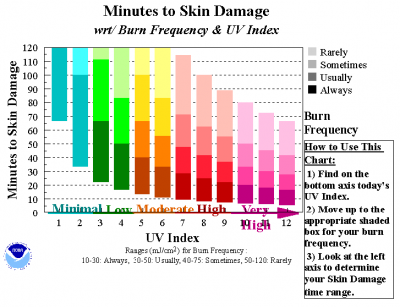Ultraviolet Intensity Measurement Experiment: Unterschied zwischen den Versionen
Dl8rds (Diskussion | Beiträge) (Die Seite wurde neu angelegt: „== Project Scope == When my daughter (my first child) was still a baby, my father bought a UV sensor so he could measure the UV intensity. Babys are very sens…“) |
Dl8rds (Diskussion | Beiträge) (→Solution Concept) |
||
| Zeile 11: | Zeile 11: | ||
There are pairs of ML8511 sensors, one pair simply behind the SiO (Silicium Oxide / Quarz glass), and another pair behind a lowpass UVB filter so that these two can measure exclusively UV-A. The UVB intensity is then the difference between the tutal power in this spectral region minus the UVA. | There are pairs of ML8511 sensors, one pair simply behind the SiO (Silicium Oxide / Quarz glass), and another pair behind a lowpass UVB filter so that these two can measure exclusively UV-A. The UVB intensity is then the difference between the tutal power in this spectral region minus the UVA. | ||
| − | Here is a nice overview of | + | Here is a nice overview of sunburn effects: |
| − | [[Image:2017-07-31-sunburn1. | + | [[Image:2017-07-31-sunburn1.png|400px]] |
== Component List == | == Component List == | ||
Version vom 31. Juli 2017, 22:39 Uhr
1 Project Scope
When my daughter (my first child) was still a baby, my father bought a UV sensor so he could measure the UV intensity. Babys are very sensitive to UV light and the worst thing he could image was a baby sunburn.
So I thought, what about creating an alarm sensor that would measure UV intensity continuously. The result is this experiment, years later but no less outdated.
2 Solution Concept
I decided to build up the entire solution on the basis of a PoE 803.af Arduino Ethernet, including measurement of environment data and ambient light, including a solar cell based voltage verification.
There are pairs of ML8511 sensors, one pair simply behind the SiO (Silicium Oxide / Quarz glass), and another pair behind a lowpass UVB filter so that these two can measure exclusively UV-A. The UVB intensity is then the difference between the tutal power in this spectral region minus the UVA.
Here is a nice overview of sunburn effects:
3 Component List
- Hammond 1550E aluminium diecast case: 50 €
- 2sided base PCB: 2 €
- Arduino Ethernet: 35 €
- Programmer: 3 €
- Watterott BME280: 14 €
- 4x Sparkfun ML8511: 4x 15€ = 60 €
- 1x Sparkfun TEMT6000: 5 €
- https://www.sparkfun.com/products/8688
- https://learn.sparkfun.com/tutorials/temt6000-ambient-light-sensor-hookup-guide
- Adafruit ADS1115: 15 €
- 2 solar cells: 5 €
- screws, mounts: 10 €
- Edmund Optics UVB lowpass: 80 €
- Cut-Off Position λc (nm): 309±6
- https://www.edmundoptics.com/optics/optical-filters/longpass-edge-filters/n-wg-305-50.8mm-sq.-longpass-filter/
- Quarz glass to pass all wavelengths: 65 €
- Silicon glue: 10 €
- TP-Link PoE injector: 25
Total: 369 €
